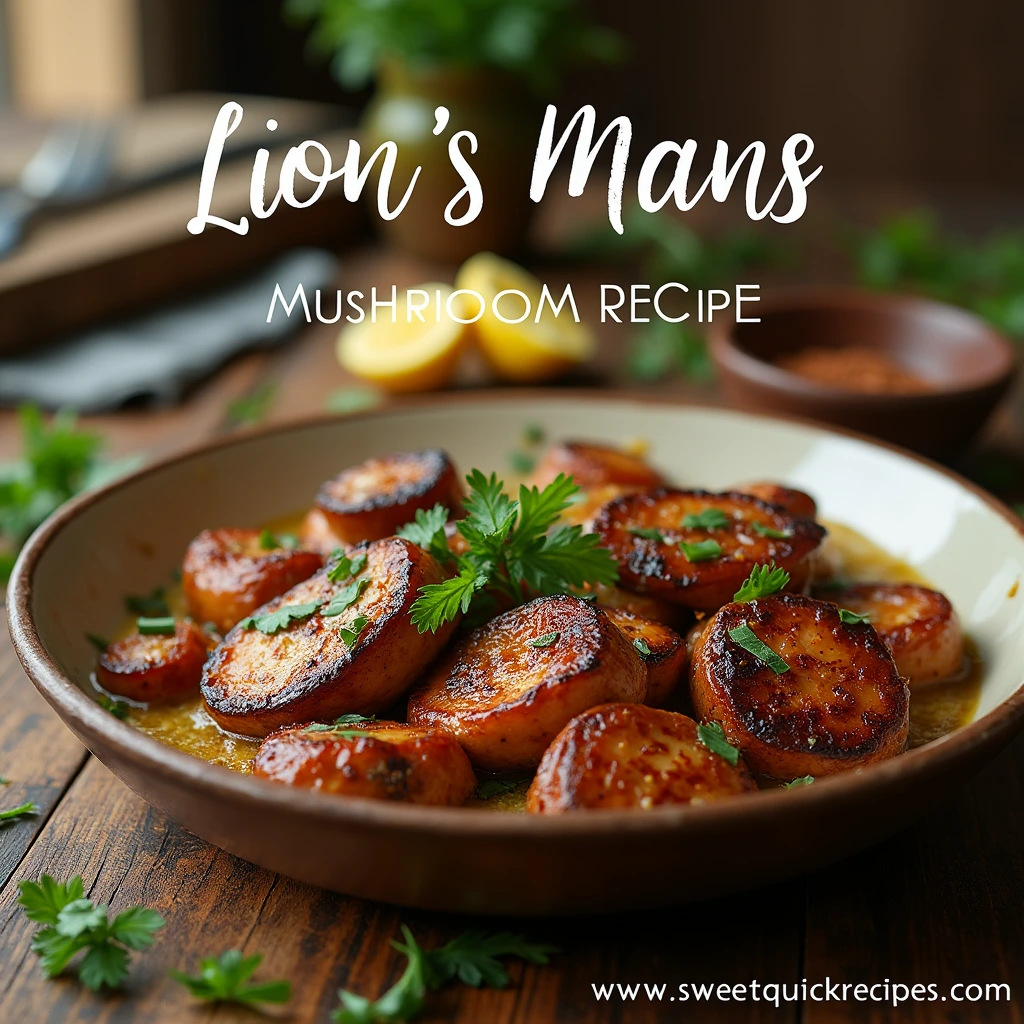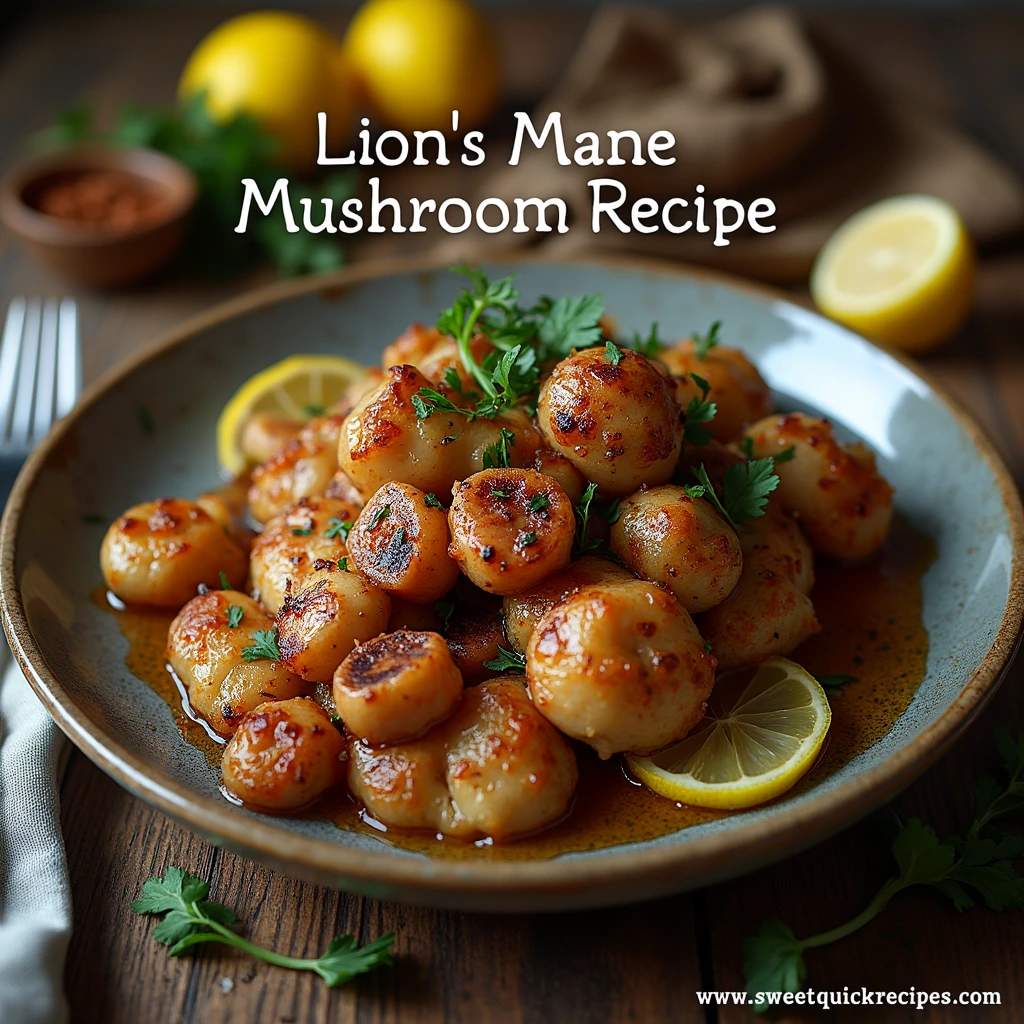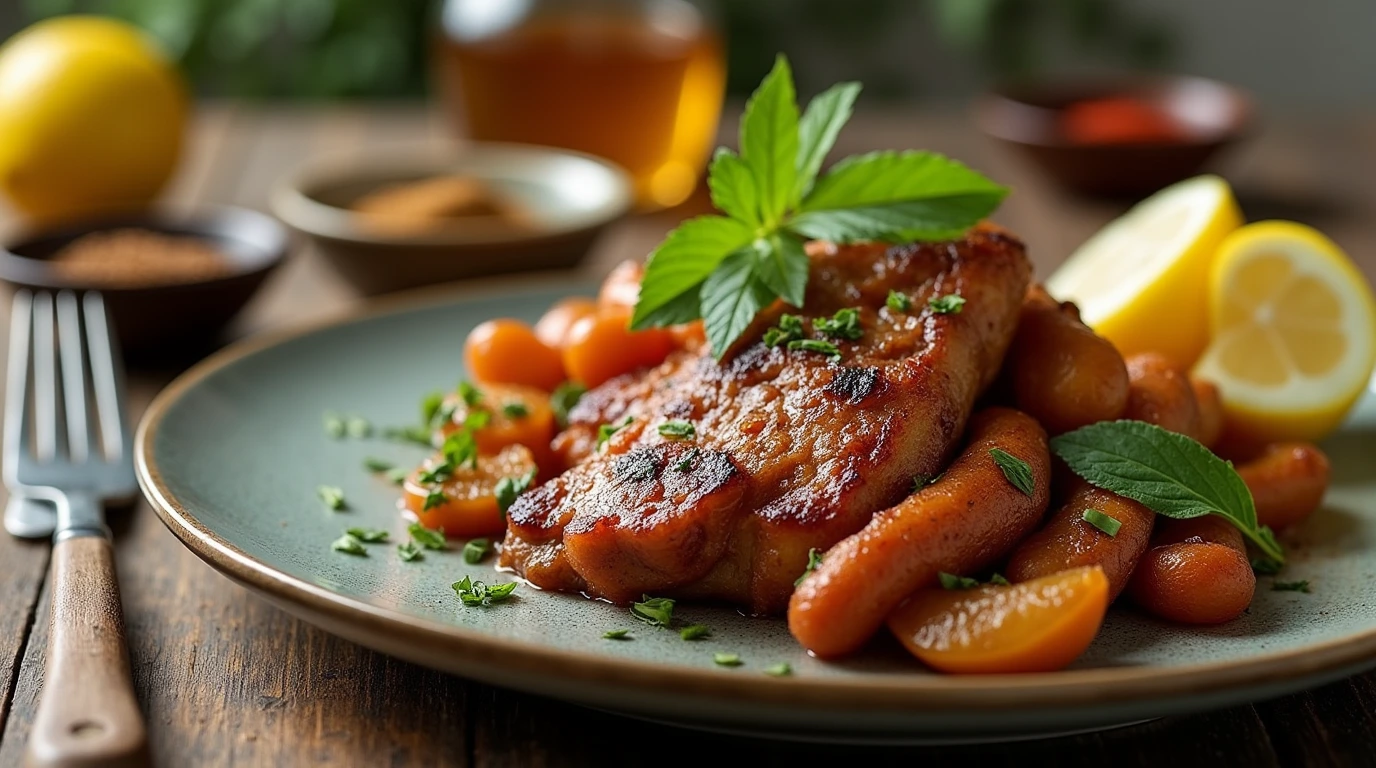How to Make the Perfect Lion’s Mane Mushroom Recipe
Lion’s mane mushrooms are a versatile, nutritious ingredient that elevates any dish. Known for their lobster-like texture and delicate flavor, these unique fungi have become a favorite for health-conscious food lovers. Whether you’re a seasoned chef or a home cook experimenting in the kitchen, this guide will teach you how to prepare a mouthwatering lion’s mane mushroom recipe that’s as healthy as it is delicious.
What is Lion’s Mane Mushroom?
Lion’s mane mushroom, also known as Hericium erinaceus, is a distinctive, shaggy white fungus that grows on hardwood trees. Revered for its health benefits, this mushroom is packed with antioxidants, supports brain health, and is known for its adaptogenic properties. Its meaty texture and mild seafood flavor make it a fantastic meat alternative in vegetarian and vegan recipes.
Health Benefits of Lion’s Mane Mushrooms
Before diving into the recipe, it’s worth noting why lion’s mane mushrooms deserve a spot on your plate:
- Boosts Cognitive Function: Contains hericenones and erinacines, compounds that support nerve growth and brain health.
- Supports Digestive Health: Rich in prebiotics, it promotes a healthy gut microbiome.
- Anti-Inflammatory Properties: Helps reduce inflammation, supporting overall wellness.
- Immune Support: Packed with antioxidants that enhance immunity.
Ingredients for a Simple Lion’s Mane Mushroom Recipe
To create a dish that showcases the mushroom’s unique flavor, keep the ingredients simple:
- 1 pound fresh lion’s mane mushrooms
- 2 tablespoons olive oil or butter
- 3 cloves garlic, minced
- Salt and black pepper to taste
- Fresh parsley or thyme for garnish
- Optional: A splash of white wine or soy sauce for added depth.

Step-by-Step Guide to Cooking Lion’s Mane Mushrooms
Preparing the Mushrooms
- Clean the Mushrooms: Use a damp cloth or soft brush to remove dirt. Avoid soaking them in water, as they can absorb it and become soggy.
- Slice or Tear: Cut the mushrooms into thick slices or tear them into pieces resembling lobster chunks.
Sautéing the Mushrooms
- Heat the Pan: Place a heavy skillet over medium heat and add olive oil or butter.
- Add Garlic: Once the oil is hot, add the minced garlic and sauté until fragrant. Be careful not to burn it.
- Cook the Mushrooms: Add the lion’s mane slices to the pan. Let them cook undisturbed for 2-3 minutes on each side until golden brown.
- Season: Sprinkle with salt and pepper to taste. For extra umami, add a splash of soy sauce or white wine.
Finish and Serve
- Garnish: Top with fresh parsley or thyme for color and flavor.
- Serve Hot: Pair with crusty bread, pasta, or enjoy as a standalone appetizer.
Creative Variations of Lion’s Mane Mushroom Recipes
Lion’s Mane Mushroom “Crab Cakes”
- Mix shredded lion’s mane mushrooms with breadcrumbs, vegan mayo, and Old Bay seasoning. Shape into patties and pan-fry until golden.
Lion’s Mane Mushroom Stir-Fry
- Toss cooked lion’s mane mushrooms with soy sauce, ginger, and mixed vegetables for an Asian-inspired dish.
Lion’s Mane Mushroom Soup
- Simmer lion’s mane mushrooms with vegetable stock, onions, and coconut milk for a creamy, comforting soup.
Lion’s Mane Mushroom Tacos
- Season the mushrooms with cumin, paprika, and lime juice, then serve in soft tortillas with avocado and salsa.
Lion’s Mane Mushroom Recipe Tips
- Avoid Overcrowding the Pan: Cook mushrooms in small batches for even browning.
- Experiment with Flavors: Lion’s mane absorbs seasoning well, so feel free to explore herbs and spices.
- Storage: Store unused mushrooms in a paper bag in the fridge for up to a week.
Lion’s Mane Mushroom Recipe FAQs
How do I know when lion’s mane mushrooms are cooked?
- They should be golden brown on the outside and tender inside.
Can I freeze lion’s mane mushrooms?
- Yes, blanch them briefly in boiling water before freezing.
Do lion’s mane mushrooms taste like seafood?
- Many people describe their flavor as similar to crab or lobster.
Are lion’s mane mushrooms good for weight loss?
- Yes, they’re low in calories and high in fiber, making them great for weight management.
Can I use dried lion’s mane mushrooms in recipes?
- Rehydrate them in warm water before cooking for a similar texture to fresh mushrooms.
What dishes pair well with lion’s mane mushrooms?
- They pair beautifully with pasta, risotto, or as a topping for steak or roasted vegetables.
Conclusion
Cooking with lion’s mane mushrooms is a delightful culinary adventure that blends taste with nutrition. Whether you’re making a simple sauté, a creamy soup, or experimenting with crab cakes, these mushrooms bring a gourmet touch to any dish. With their health benefits and versatile flavor profile, lion’s mane mushrooms are a must-try for any food enthusiast.
Serving Suggestions for Lion’s Mane Mushroom Recipes
Lion’s mane mushrooms shine in many dishes, and their subtle flavor profile makes them incredibly versatile. Here are some ideas for how to serve your freshly cooked lion’s mane mushrooms:
- As a Side Dish: Pair with grilled fish, roasted chicken, or a hearty lentil stew.
- In a Sandwich: Layer sautéed mushrooms on toasted sourdough with arugula, goat cheese, and a drizzle of balsamic glaze.
- Topping for Pizza: Add cooked lion’s mane mushrooms to a pizza topped with mozzarella, caramelized onions, and fresh basil.
- Over Risotto: Serve atop a creamy wild mushroom risotto for a rich and earthy dinner.
Why Choose Lion’s Mane Mushrooms Over Other Mushrooms?
Lion’s mane mushrooms stand out not only for their health benefits but also for their unique texture and flavor. Unlike more common mushrooms like button or portobello, lion’s mane has a fibrous, almost meaty texture that mimics seafood. Their adaptogenic properties also set them apart, making them a favorite among those looking for natural ways to support stress management and mental clarity.
The Perfect Wine Pairing for Lion’s Mane Mushroom Dishes
Enhance your lion’s mane mushroom recipe with the right wine pairing:
- White Wines: A crisp Sauvignon Blanc or a buttery Chardonnay complements the mushroom’s subtle seafood-like flavor.
- Light Reds: Opt for a Pinot Noir for a balanced pairing with richer mushroom dishes like risotto or pasta.
- Rosé: A dry rosé offers a refreshing contrast to the earthy tones of lion’s mane mushrooms.
Lion’s Mane Mushroom for Vegan and Vegetarian Diets
For those following plant-based diets, lion’s mane mushrooms are a game-changer. They provide a satisfying texture and rich umami flavor that can replace meat in many recipes. Their versatility allows them to be used in:
- Vegan burgers or sliders
- Plant-based stir-fries
- Hearty stews and casseroles
Exploring More with Lion’s Mane Mushroom Recipes
The culinary possibilities for lion’s mane mushrooms are endless. If you’re feeling adventurous, try incorporating them into unconventional dishes like mushroom-based desserts (yes, that’s a thing!) or blending them into smoothies for an earthy undertone.
For those who love fusion cuisine, lion’s mane mushrooms can be seasoned with spices from around the world—think garam masala for an Indian twist or miso and sesame oil for a Japanese-inspired dish.
Sustainable Sourcing of Lion’s Mane Mushrooms
Lion’s mane mushrooms are often cultivated sustainably, making them a great choice for eco-conscious cooks. If you can’t find fresh mushrooms locally, many specialty stores and online retailers offer dried or powdered lion’s mane, which works well in soups, teas, and smoothies. Supporting small-scale mushroom farmers is another way to ensure sustainability.
Cooking Lion’s Mane Mushrooms for Meal Prep
Lion’s mane mushrooms are ideal for meal prep because they hold up well in the fridge. Prepare a large batch and use them throughout the week in various dishes.
- Storage Tip: Store cooked mushrooms in an airtight container for up to four days.
- Reheating: Gently reheat in a skillet to retain their texture and flavor.
- Make-Ahead Dishes: Add them to pre-made pasta, grain bowls, or wraps for quick, nutritious meals.

Fun Facts About Lion’s Mane Mushrooms
- Lion’s mane mushrooms have been used in traditional Chinese medicine for centuries.
- They are sometimes called “pom pom mushrooms” due to their fluffy appearance.
- These mushrooms can grow up to a foot in diameter in the wild!
- Scientists are researching their potential to combat neurodegenerative diseases like Alzheimer’s.
Final Thoughts on the Lion’s Mane Mushroom Recipe
Lion’s mane mushrooms are not just an ingredient—they’re an experience. Cooking them is a sensory delight, from their unique texture to their delicate, savory aroma. By experimenting with these recipes, you can discover the joy of bringing gourmet flavors into your home kitchen.
So, why not try a lion’s mane mushroom recipe today? Whether you’re sautéing them with garlic or crafting intricate crab cakes, these fungi promise to impress your taste buds and nourish your body.
Start your culinary journey with lion’s mane mushrooms and experience the perfect blend of flavor, texture, and nutrition!
How to Grow Lion’s Mane Mushrooms at Home
If you’re captivated by the unique taste and benefits of lion’s mane mushrooms, why not grow your own? Cultivating lion’s mane at home is surprisingly straightforward and can save you money while ensuring a fresh supply. Here’s a simple guide to get started:
Supplies Needed
- A lion’s mane mushroom growing kit (available online or at gardening stores)
- Sterile growing medium (such as hardwood sawdust or sterilized grain)
- A humid environment (like a mini greenhouse or a plastic tub with ventilation holes)
- A spray bottle for misting
Steps to Grow Lion’s Mane Mushrooms
- Prepare the Substrate: Follow the instructions on your growing kit to inoculate the substrate with lion’s mane mushroom spores or mycelium.
- Maintain Humidity: Keep the growing environment moist but not soggy. Mist daily and ensure good air circulation to prevent contamination.
- Monitor Growth: Within 2-4 weeks, you’ll see small “pinheads” appear. These will grow into mature mushrooms within a few days.
- Harvest: Gently twist and pull the mushrooms when they’re fully grown but still firm.
Growing your own lion’s mane mushrooms is a rewarding hobby that provides fresh ingredients and an opportunity to connect with nature.
Cooking with Dried Lion’s Mane Mushrooms
If fresh lion’s mane mushrooms aren’t available, dried mushrooms are a fantastic alternative. They retain their nutritional value and flavor and are easy to store for long periods.
How to Use Dried Lion’s Mane Mushrooms
- Rehydrate: Soak the mushrooms in warm water for 15-20 minutes until soft. Save the soaking liquid to enhance soups and sauces.
- Cook as Fresh: Use rehydrated mushrooms in recipes just as you would fresh ones.
Recipe Idea: Lion’s Mane Mushroom Broth
Combine rehydrated mushrooms, their soaking liquid, vegetable stock, garlic, and ginger for a savory and comforting broth. This is perfect for sipping or as a base for noodle dishes.
Lion’s Mane Mushroom Tea: A Unique Beverage
For a truly unique way to enjoy lion’s mane mushrooms, consider brewing them into tea. This traditional preparation is believed to harness their cognitive and immune-boosting benefits.
Lion’s Mane Mushroom Tea Recipe
- Ingredients:
- 1-2 dried lion’s mane mushrooms
- 2 cups water
- Optional: Honey, lemon, or ginger for flavor
- Instructions:
- Bring water to a boil and add the dried mushrooms.
- Simmer for 20-30 minutes to extract the flavor and nutrients.
- Strain and serve hot, sweetened with honey or lemon if desired.
Exploring Global Lion’s Mane Mushroom Dishes
Lion’s mane mushrooms have made their way into cuisines around the world, showcasing their adaptability. Here are some international-inspired ideas:
- Japanese Cuisine: Use lion’s mane mushrooms in tempura batter for crispy mushroom bites.
- Italian Dishes: Add them to creamy fettuccine Alfredo or a rustic mushroom risotto.
- Mexican Tacos: Toss with chipotle seasoning and serve in warm tortillas with fresh cilantro.
- Chinese Stir-Fry: Cook with soy sauce, sesame oil, and bok choy for a quick and healthy meal.
Lion’s Mane Mushroom as a Meat Substitute
With its meaty texture, lion’s mane mushrooms are a fantastic alternative to meat. They can replicate the texture of seafood, chicken, or even pulled pork.
Lion’s Mane “Pulled Pork” Recipe
- Tear lion’s mane mushrooms into thin strips.
- Sauté with BBQ sauce, onions, and garlic until tender and caramelized.
- Serve on a bun with coleslaw for a plant-based barbecue delight.
Where to Buy Lion’s Mane Mushrooms
If you’re eager to try lion’s mane mushrooms but unsure where to find them, here are some options:
- Farmers’ Markets: Many local growers sell fresh lion’s mane mushrooms.
- Specialty Grocery Stores: Look for them in the produce section or mushroom aisle.
- Online Retailers: Order fresh, dried, or powdered lion’s mane mushrooms from reputable websites.
The Future of Lion’s Mane Mushrooms in Culinary Trends
As interest in plant-based eating continues to rise, lion’s mane mushrooms are likely to become even more popular. Their versatility, health benefits, and unique flavor make them a star ingredient in modern cuisine. Chefs and food enthusiasts alike are exploring creative ways to incorporate these mushrooms into menus, from gourmet dishes to street food-inspired creations.
Final Thoughts
Lion’s mane mushrooms are more than just a trendy ingredient—they’re a culinary gem with a rich history, impressive health benefits, and endless potential in the kitchen. Whether you’re sautéing them simply with garlic, crafting a gourmet dish, or exploring their medicinal uses in teas and broths, these mushrooms offer something special for every palate.
Start experimenting today, and discover how lion’s mane mushrooms can transform your meals into something extraordinary.
Incorporating Lion’s Mane Mushrooms into a Healthy Lifestyle
Lion’s mane mushrooms are not only delicious but also play a role in supporting a balanced, health-conscious lifestyle. With their high nutrient content and low-calorie profile, they fit perfectly into various diet plans. Here’s how you can incorporate them into your daily routine:
Breakfast Boost
- Add sautéed lion’s mane mushrooms to omelets or scrambled eggs for a savory start to the day.
- Toss them into a morning smoothie in powdered form for a cognitive and immune boost.
Lunch Ideas
- Use them as a topping for whole-grain bowls alongside quinoa, roasted vegetables, and a drizzle of tahini.
- Create a lion’s mane mushroom sandwich with whole-grain bread, fresh greens, and a light aioli.
Dinner Delights
- Substitute them for seafood in classic pasta dishes like linguine with clam sauce or mushroom scampi.
- Incorporate them into hearty stews, curries, or stir-fries for a protein-rich main dish.
Lion’s Mane Mushroom as Part of a Holistic Wellness Routine
Beyond the kitchen, lion’s mane mushrooms can also be part of a wellness routine due to their potential medicinal properties. Here’s how:
- Supplements: Take lion’s mane mushroom extracts or capsules to support cognitive health and nerve repair.
- Mushroom Powder: Add it to teas, coffees, or baked goods for daily nutritional benefits.
- Adaptogenic Blends: Combine with other functional mushrooms like reishi and chaga for a synergistic wellness boost.
How to Identify Fresh Lion’s Mane Mushrooms
When purchasing fresh lion’s mane mushrooms, look for the following indicators of quality:
- Appearance: The mushroom should have a white or slightly off-white color with a shaggy, hair-like texture.
- Texture: Fresh lion’s mane mushrooms feel firm to the touch. Avoid those that are mushy or overly soft.
- Aroma: They should have a mild, earthy scent. A sour or unpleasant smell indicates spoilage.
Preserving Lion’s Mane Mushrooms
To extend the shelf life of lion’s mane mushrooms and ensure their quality, proper storage is essential. Here’s how:
Short-Term Storage
- Place fresh mushrooms in a paper bag to allow them to breathe. Store in the refrigerator for up to one week.
Long-Term Preservation
- Freezing: Cook the mushrooms first, then freeze in airtight containers for up to three months.
- Drying: Use a dehydrator or air-dry the mushrooms for later use in soups and teas.
The Science Behind Lion’s Mane Mushrooms’ Health Benefits
Recent studies have shed light on the unique compounds in lion’s mane mushrooms and their potential effects on health. Some key findings include:
- Nerve Growth Factor (NGF): Lion’s mane contains compounds that stimulate the production of NGF, which supports brain health and nerve regeneration.
- Cognitive Enhancement: Research suggests that lion’s mane may improve memory and focus, making it a popular choice for nootropic enthusiasts.
- Immune Modulation: Polysaccharides in lion’s mane mushrooms help strengthen the immune system by promoting the production of white blood cells.
Lion’s Mane Mushrooms in Culinary Culture
Lion’s mane mushrooms are becoming a popular ingredient in high-end restaurants and wellness-focused eateries. Chefs praise their ability to mimic seafood, and they’re increasingly featured in:
- Vegan and vegetarian fine dining menus.
- Street food innovations, such as mushroom-based “lobster rolls.”
- Health-conscious cafes serving lion’s mane-infused coffee and teas.
How to Source Lion’s Mane Mushrooms Sustainably
As demand for lion’s mane mushrooms grows, it’s important to support sustainable practices in their cultivation. Here are some tips for sourcing responsibly:
- Look for Certified Organic: Organic lion’s mane mushrooms are grown without harmful pesticides or chemicals.
- Support Local Farmers: Buying from local growers reduces the carbon footprint associated with transporting fresh mushrooms.
- Grow Your Own: Home cultivation ensures the freshest mushrooms while supporting sustainability.
Why Lion’s Mane Mushrooms Are a Culinary Superfood
Lion’s mane mushrooms check all the boxes for a superfood: they’re nutrient-dense, versatile, and packed with antioxidants. Whether you’re focusing on taste, health benefits, or sustainability, they offer a perfect solution for the modern kitchen.
Conclusion
Lion’s mane mushrooms are truly a culinary treasure, offering a remarkable combination of flavor, nutrition, and versatility. Whether you’re exploring traditional recipes or inventing your own, these mushrooms can elevate your cooking to new heights. From brain health to immunity, they bring a wealth of benefits that go beyond the plate.
Embrace the potential of lion’s mane mushrooms today and turn every meal into an opportunity for wellness and flavor. With simple techniques and endless possibilities, you’re just a recipe away from a healthier, more flavorful lifestyle.
Follow us for recipes on Facebook

